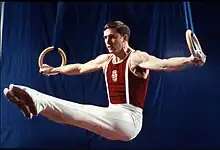.jpg.webp)
Eleftherios Petrounias performs an iron cross during his gold medal routine at the 2016 Olympics

L cross
_140.jpg.webp)
Maltese cross
_198.jpg.webp)
Inverted cross
An iron cross, also known as a crucifix[1] or cross,[2] is a gymnastics skill on the rings in which the body is suspended upright while the arms are extended laterally, forming the shape of the Christian cross. It is a move that requires significant shoulder and bicep tendon strength.
The International Gymnastics Federation Code of Points refers to the skill as a cross and lists it as a "B" difficulty value strength hold element.[3][4]
Variants
Variations of the iron cross listed in the FIG Code of Points include:
- L cross (B difficulty): the cross is performed with the body held in an L-sit position.[4]
- V cross (C difficulty): the cross is performed with the body in a tight piked position and the legs held vertically.[4]
- Inverted cross (C difficulty): the cross is performed in an inverted (upside down) position.[4]
- Maltese cross or swallow (D difficulty): the gymnast holds his body parallel to the ground at ring height with arms extended laterally.[4]
- Victorian cross or inverted swallow (E difficulty): an inverted Maltese cross, with the body held parallel to the ground and facing up.[4]
See also
References
- ↑ Fukushima, Sho; Russell, Wrio (1980). Men's gymnastics. Faber & Faber. pp. 94–95. ISBN 0-571-11478-4.
- ↑ Tatlow, Peter (1979). Gymnastics. Lyric Books Limited. p. 76. ISBN 0-07-0935351.
- ↑ "FIG - Discipline". www.gymnastics.sport. Fédération Internationale de Gymnastique. Retrieved 18 March 2021.
- 1 2 3 4 5 6 Fédération Internationale de Gymnastique (February 2020). 2022 – 2024 Code of Points:Men's Artistic Gymnastics (PDF). FIG Executive Committee. p. 86.
External links
Wikimedia Commons has media related to Category:Iron cross (gymnastics).
This article is issued from Wikipedia. The text is licensed under Creative Commons - Attribution - Sharealike. Additional terms may apply for the media files.